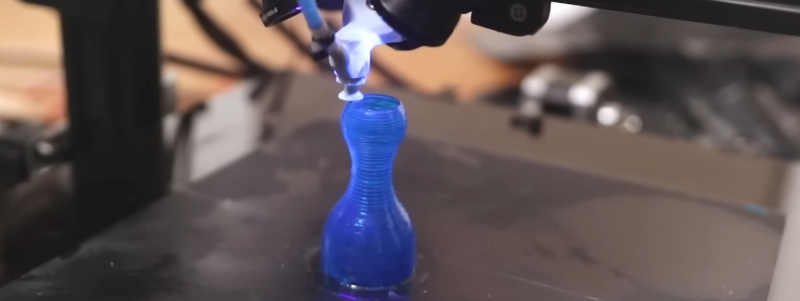[Proper Printing] is at it again. He’s trying to perfect his hybrid printer that works like an FDM printer but uses UV-curable resin gel instead of filament. You can see the latest update video below. If you missed our take on his early attempts, you might want to catch up with those earlier videos first.
The latest update brings a new nozzle, an improved light source, and changes to the formula of the resin. The nozzle and light source improvements hinge on conical lenses that convert the laser beams from a spot to a ring. The initial nozzles looked like the business end of a syringe, but this wasn’t very stable. The new video shows a conventional nozzle which also had some issues. This resulted in a custom-made nozzle that solved all the issues with the conventional nozzle and the syringe tips.
The resin formula is particularly crucial. The second attempt used resin with glass beads to give thickness. That wasn’t without problems, though, so it was switched this time with fused silica, as suggested by some comments on a previous video. They also used aggressive mixing and air removal. The consistency of the previous resins was that of a paste, but according to the video, the new mixture is more like a gel.
At some point, things started going badly. There were several equipment failures. Exasperated, he was ready to give up and was editing the video when he had an epiphany. We’re glad he didn’t give up because the new results are pretty impressive.
These printers remind us of some strange laser CNC. It also reminds us a little of people curing resin outside of the normal print process.
















Finally! I really wanted a 3D printer that combines all the downsides of FDM with all the downsides of SLA.
Human ingenuity really knows no bounds.
Yeah this is worst of both worlds and incredibly difficult to boot…
I admire this kind of guy a lot.
It has upsides too, avoiding problems with filament flow and temperature management. Layer adhesion is probably also better, and you don’t need a large open pool of resin that you always lose a fraction of, nor expendable screens for exposing each layer.
An embedded printing method (Similar to FRESH printing used in Bioprinting) would achieve the same thing but without having to mess around with instant curing – Carbomer gels aren’t hard to prepare, and can be washed away.
It does have one very notable upside: the ability to build very large monolithic objects without using thermosoftening plastics (i.e. every FDM filament, even ‘high temperature’ ones) and without needing an exorbitant SLA printer and a massive vat of resin, and without needing subsequent reprocessing (e.g. printing a mould and then casting resin).
Why monolithic? Does this method for some reason not work if you try to print two or more parts, not attached to one another?
Why large? How is the maximum size any different than the same build area with FDM?
Printing materials that don’t melt in high temperatures while not having to expose a whole vat of expensive resin to air just to print a part that uses a tiny fraction of the vat.. Ok, that is an advantage I can understand.
you do realize that there are commercial products that do this already. From the company Massivit. So there are advantages to using this method.
What are the advantages?
Hmm, interesting…
I just took a quick look at Massivit and from what I could quickly gather, the advantages are as follows:
–Without the filament heating/cooling time it can allow you to print faster.
–Without the heating/cooling thermal expansion/contraction it can allow for better precision than a normal melted material FDM printer.
–These two advantages together make their UV Cured FDM approach amenable to really large scale, but still accurate, prints.
UV Resin FDM, 3d printing for masochists.
That would be fuMed silca, not fuSed silica.
Fumed silica is a standard, very effective gelling agent for epoxies.
Superfine, goes airborne very easily though. Respirator required.
I see a possibile future advantage of using this tecnique in an idex 3d printer with 2nd head a traditional FDM, to make parts that mix filament with special performance with resins with different properties. This thing Is for masochists but I absolutely love It
It might be worth pointing out that he is doing this all to eventually print with continuous fibres, that are to be impregnated with the resin just before extrusion.
while discussion can be had about the usefulness of this, given shadows caused by the fibres and PMMA being not really a good matrix material and all that, his goal is not to marry the difficulties and resolution of FDM with the mess and chemical worries of MSLA printing.
Very nice! I have been toying with this also. For bridging, your laser shield is too large and blocks the “instant” cure. Perhaps washer on the nozzle tube. Also a temperature control would allow on-the-move viscosity and cure control, reaction is catalyzed by heat. Thank you keep up the great work 👍.
Ps the washer could have different defuse properties.